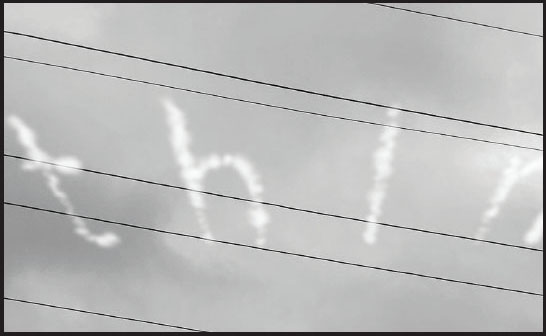
The make of the altimeter used by Art Smith, The Bird Boy of Fort Wayne, was a Tycos. The inscription on its face read: SHORT & MASON, LTD. LONDON. Art Smith modified the instrument, soldering wire on the back of the case to create loops allowing for a leather strap to be threaded through the openings so that the device might be worn on his wrist. The altimeter measured altitude by means of gauging the atmospheric pressure, the vast mass of the air weighing down upon the earth. Art Smith referred to the air at the altitude where he did his work skywriting as “thin.” Up there, he said many times, he felt a great weight lift off of him. He would float, he reported, as he nosed his airplane earthward whilst attaining the highest point on the arc of the terminal “n.”
Often, Art Smith, The Bird Boy of Fort Wayne, would attempt to map the density of the various layers he would sense embedded in the wind stream. Flying through the clear clean air, he marked the gradients of the many transitions through the thinning atmosphere with the tell-tale epitaphs of smoke generated by his skywriting machine, mirroring the wispy strands of cirrus clouds floating even farther above the diminishing messages, a kind of airy moth-eaten parchment written upon by disappearing ink.
Art Smith would many times trace the seam between the high and low pressure systems he found aloft, a topography through the clouds, a vector demarcating the leading edge of the front’s face often traveling for miles to the point that the fuel feeding his skywriting apparatus ran out. On one such occasion upon the exhaustion of that fuel, Art Smith noticed that the plane itself was producing a similar airy vapor from the vortices of wind his wings created. He dubbed the thin trails of smoke “contrails,” a kind of elongated cloud generated by the moisture in the air, condensed when forced over the wing at high altitudes and high speed. He thought then of course of the aerial combat of the Great War, its Armistice recently concluded, and another kind of cursive line airplanes emitted—the oily smoke of burning fuel ignited by machine gun fire, the spiral punctuation mark written with gravity’s grave hand, the emphatic gesture underlining this withdrawn miracle flight in the transparent medium of the sky.
At great heights and at such distances, the inviolable laws of perspective dictated the appearance of this skywriting over Fort Wayne in the summer of 1922. The hairbreadth needle pointer of Art Smith’s altimeter swept over the instrument’s inner dial. That face was scaled to a barometer, measuring pressure in pounds per square inch. The outer dial’s scale, meshed with the bezel, was calibrated in feet and was rotated to score the elevation of the launching at the time and place of take off. Fort Wayne is 810 feet above sea level. Smith’s altimeter, its crystal cracked and its case scorched from the fire of his final flight, was recovered along with the locket containing a strand of his mother’s hair, slightly singed. The altimeter was found, upon its repair in 1950 by James Wigner, to be miscalibrated, off by nearly three hundred feet.